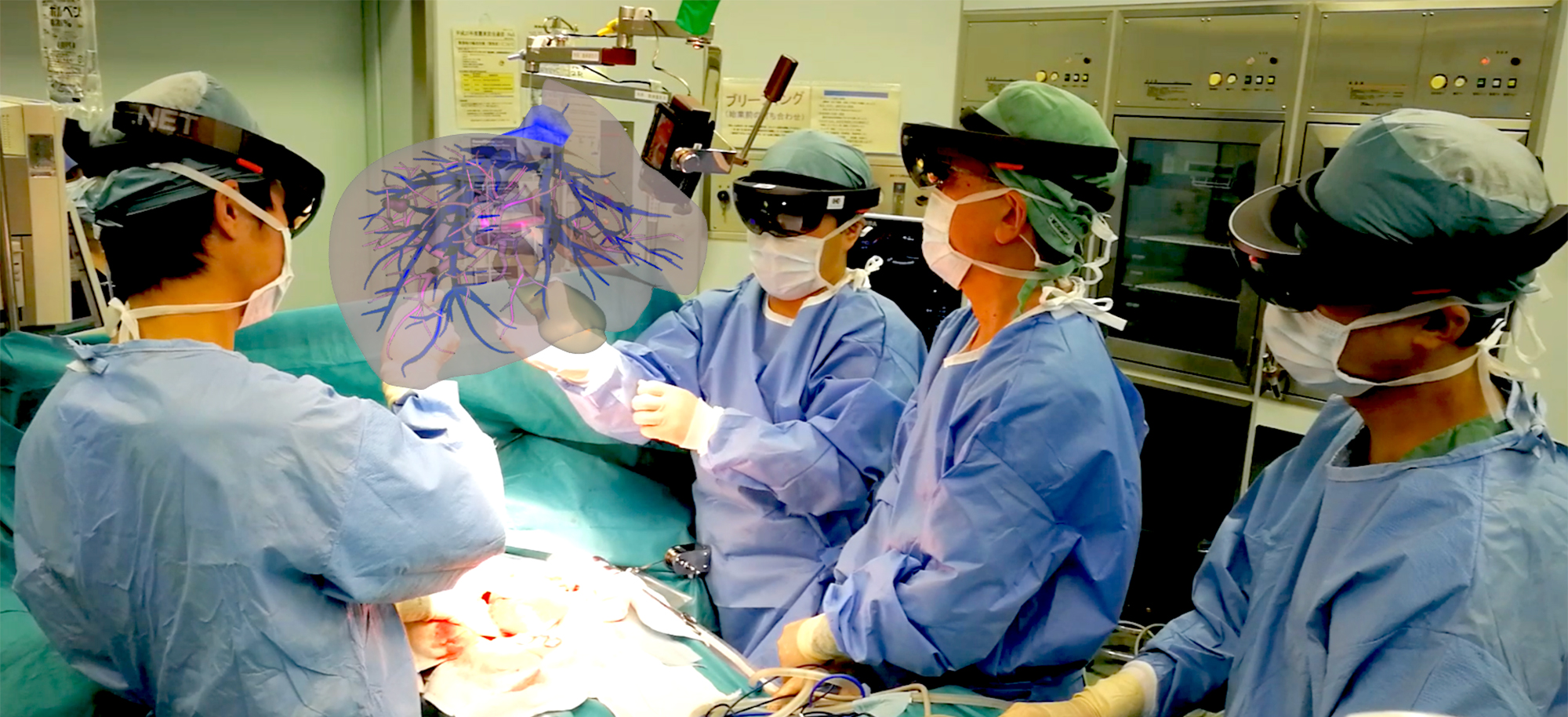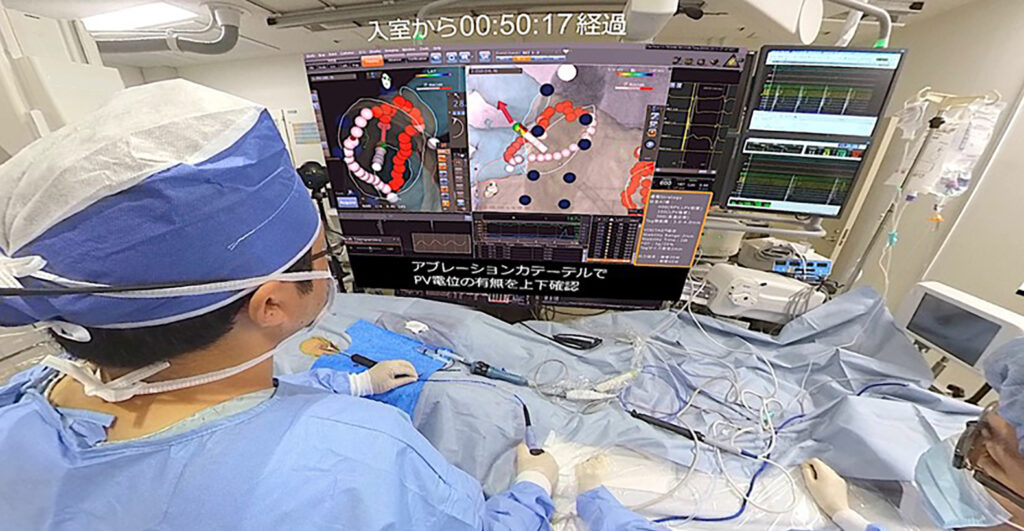VR (Virtual Reality) technology has a strong image in the fields of games and entertainment, but it has also advanced in terms of application area and quality for medical use, and in addition to surgical simulation and navigation, patient pain and PTSD (post-traumatic stress) It is also used to reduce anxiety such as disability).

VR is a technology that stimulates human sensory organs and makes virtual space by computer feel like reality. In the medical field, it is possible to obtain a feeling close to real surgery by applying a training system. In training using VR simulation, it is possible to practice repeatedly, and it is expected to acquire effective techniques by evaluating acquired skills, rare cases, and experiencing dangerous procedures. By performing surgical simulation with high-definition VR images, it is possible to train the procedure without any time or place restrictions. One of the merits is that by gaining a lot of experience in virtual space, you can confidently face the actual surgery.
Medical Realities in the United Kingdom has developed VR for surgical training. Until now, only a few people could observe the surgery up close in the operating room, but with this VR, it is possible for many residents to see the surgery next to the surgeon outside the operating room. It will be possible.
By installing multiple cameras at various angles around the operating room to create a 360-degree field of view, trainees wear VR headsets and immerse themselves in the surgical environment. In addition, anatomical images can also be referenced in a virtual environment in this VR. By using a dedicated app for video, anyone with a VR headset can access VR operations.
The training VR for catheter ablation for atrial fibrillation developed by Johnson & Johnson contains a video of a procedure actually performed by a specialist who is proficient in catheter ablation, taken with a high-precision 360-degree camera ( photo1). By simply wearing a head-mounted display, you can experience surgery from the same perspective as a surgeon who is familiar with catheter ablation. It also contains commentary by the specialist who performed the surgery, enabling trainees to learn effectively without having to be present at the surgical site.
In addition, the development of surgical navigation utilizing MR (Mixed Reality) is underway. MR is a technology that combines information from the virtual world and the real world artificially created by computer graphics, etc., to fuse the real world and the virtual world, and to realize a world in which each other influences each other in real time. Until now, surgery has relied on experience and intuition, such as doctors converting images from CT scans into 3D in their heads and performing surgery. At Holoeyes, 3D images created from the patient's CT and MRI diagnostic images are superimposed on the actual field of view, allowing the patient's 3D model organs and blood vessels to be freely manipulated and observed. By doing so, it is possible to find blood vessels hidden in the back, check the location where the scalpel is inserted more accurately, and proceed smoothly with surgery even after the incision (Photo 2). The needs of this system include orthopedics, brain surgery, head and neck surgery, digestive surgery (liver / pancreas), chest surgery (lungs), and gynecology. In particular, there is demand for simulations such as spinal surgery and artificial joint replacement, as well as surgery to implant implants in the body and robot-assisted surgery. These 3D images can be shared in real time among surgical staff, and can also be used for preoperative planning of surgery and case studies at conferences. There is also the advantage of deepening the understanding of the disease by explaining it to patients and their families in three dimensions.
Oxford Medical Simulation in the United Kingdom has developed a training VR for diabetes treatment. The UK's National Health Service (NHS) diabetes team is also involved in this development. This training content addresses the emergencies of diabetics and provides 100 expert-supervised emergency scenarios. Currently, 50 doctors are receiving this training at Portsmouth and Southampton Hospitals. Hopefully this pilot study will be expanded throughout the UK.
A new treatment method for phantom limb pain using VR is also attracting attention. The mechanism of action of phantom limb pain has not been completely elucidated yet, but it is said to be pain caused by a gap between the facts and the commands from the brain. VR, which was born as this treatment method, eliminates the gap in the brain by taking a picture of the patient's healthy limb and projecting it upside down to give a simulated experience of moving the limb that should have been lost. The pain is expected to relieve. In addition, treatment experiments using AR have been conducted with good results. It is done by a Swedish research group, and the virtual arm of a person who has undergone amputation surgery is placed on the tip of the remaining arm on the image, and when the user thinks about the movement, the virtual arm moves. Patients play racing games using their virtual arms. As a result, the pain of 14 subjects who did not respond to other treatments was halved.
Attempts have also been made to apply VR to mental health-related treatments such as PTSD, phobias, and anxiety disorders. Conventional treatment is called exposure therapy, which alleviates the overreaction by confronting the patient with something or situation that he or she is afraid of. It's a painful treatment for the patient, but under the direction of the therapist, the goal is to overcome the fear rather than avoid it in a safe environment. Pseudo-experiences are difficult to set up situations, and not all patients are good at recollection.
On the other hand, VR allows patients to experience advanced visual simulations, and it is thought that patients are more likely to face and overcome emotional memory by gradually becoming accustomed to the cause of trauma. In the United States, experiments have been conducted to treat soldiers with PTSD using VR content based on the experiences of soldiers engaged in the war in Afghanistan and Iraq, and some effects have been recognized. It is said that treatment using VR is also being attempted for patients with acrophobia and aichmophobia.
Photo 1. Medical training VR that allows you to experience the actual operating room in a way that reproduces it.
 Photo courtesy of Johnson & Johnson, Inc.
Photo courtesy of Johnson & Johnson, Inc.
Photo 2. Surgical scene in which surgeons share a 3D model of the patient's liver revealed by MR in the air.
 Photo courtesy of Maki Sugimoto (COO, Holoeyes Co., Ltd., Specially Appointed Professor, Innovation Lab, Okinaga Research Institute, Teikyo University)
Photo courtesy of Maki Sugimoto (COO, Holoeyes Co., Ltd., Specially Appointed Professor, Innovation Lab, Okinaga Research Institute, Teikyo University)